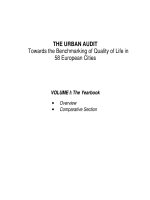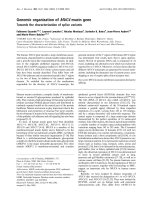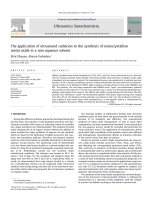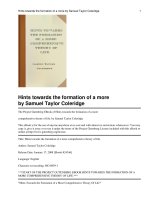Guanidine catalyzed enantioselective mannich reaction towards the synthesis of amino acids
Bạn đang xem bản rút gọn của tài liệu. Xem và tải ngay bản đầy đủ của tài liệu tại đây (5.24 MB, 240 trang )
GUANIDINE CATALYZED ENANTIOSELECTIVE
MANNICH REACTION: TOWARDS THE SYNTHESIS
OF -AMINO ACIDS
PAN YUANHANG
NATIONAL UNIVERSITY OF SINGAPORE
2011
GUANIDINE CATALYZED ENANTIOSELECTIVE
MANNICH REACTION: TOWARDS THE SYNTHESIS
OF -AMINO ACIDS
PAN YUANHANG
(BSc., Zhejiang University)
A THESIS SUBMITTED
FOR THE DEGREE OF DOCTOR OF PHILOSOPHY
DEPARTMENT OF CHEMISTRY
NATIONAL UNIVERSITY OF SINGAPORE
To my parents
for their love, support, and encouragement
Acknowledgements
I would like to take this opportunity to thank my supervisor, Associate Professor
Tan Choon-Hong, for his guidance and encouragement during my PhD research and
study. It is my honour to work with him, and his suggestions, especially his optimistic
attitude to research and life, are valuable to me, not only for my PhD study, but also
for my future career life.
I would like to thank all my labmates for creating such a harmonious,
encouraging, and helpful working environment. My special thanks go to Dr Jiang
Zhiyong, for his great help throughout my two projects and my life; Mr. Kee Choon
Wee for his kind discussion and collaboration on the decarboxylation project; Mr.
Zhao Yujun, for his collaboration on the fluorocarbon nucleophile project; Mr. Liu
Hongjun, Ma Ting and Yang Yuanyong for their kind suggestions. I also must thank
all of the former and TCH group members for their collaboration and helpful
discussions.
I thank Mdm Han Yanhui and Mr. Wong Chee Ping for their assistance in NMR
analysis, Mdm Wong Lai Kwai and Mdm Lai Hui Ngee for their assistance in Mass
analysis. I also owe my thanks to many other people in NUS chemistry department,
for their help and assistance from time to time.
Last but not least, I also would like to take this opportunity to thank all my
friends who have shared or is sharing the happy time with me in Singapore. Singapore
is a wonderful place and I enjoy my life here.
Thesis Declaration
The work in this thesis is the original work of Pan Yuanhang, performed
independently under the supervision of Associate Professor Tan Choon-Hong, (in
TCH laboratory), Chemistry Department, National University of Singapore, between
2007 and 2011.
The content of the thesis has been partly published in:
1) Chem. Eur. J. 2011, 17, 8363.
2) Chem. Eur. J. 2010, 16, 779.
__________________ __________________ ____________
Name Signature Date
I
Table of Contents
Summary
List of Schemes
List of Tables
List of Figures
List of Abbreviations
Chapter 1
Biomimetic Decarboxylative Reactions
1.1 Introduction 2
1.2 Decarboxylative Reactions Catalyzed by Metal Complexes 2
1.2.1 Condensation Reaction 2
1.2.2 Aldol Reaction 4
1.2.3 1,4-Addition 8
1.3 Organocatalytic Decarboxylative Reactions 10
1.3.1 Condensation Reaction 10
1.3.2 Aldol Reaction 11
1.3.3 1,4-Addition 13
1.3.4 Mannich Reaction 15
1.3.5 Protonation 19
1.4 Summary 21
II
Chapter 2
Bicyclic Guanidine Catalyzed Enantioselective Decarboxylative Mannich and
Amination Reactions
2.1 Introduction 26
2.2 Enantioselective Decarboxylative Mannich Reaction 30
2.2.1 Synthesis of Malonic Acid Half Thioesters (MAHTs) 30
2.2.2 Synthesis of N-Sulfonyl Imines 31
2.2.3 Synthesis of Chiral Bicyclic Guanidine 31
2.2.4 Decarboxylative Mannich Reaction of MAHTs 32
2.3 Enantioselective Decarboxylative Amination Reaction 37
2.4 Summary 40
2.5 Experimental Section 41
Chapter 3
Mechanistic Studies of Guanidine Catalyzed Decarboxylative Mannich Reaction
3.1 Introduction 76
3.2 NMR Study of the Reaction Profile 78
3.3 Mass Spectrometry Study of the Reaction Profile 80
3.4 DFT Calculation 81
3.5 Proposed Mechanism 84
3.6 Summary 86
3.7 Experimental Section 87
III
Chapter 4
Bicyclic Guanidine Catalyzed Enantioselective Mannich Reaction of
Fluorocarbon Nucleophiles
4.1 Fluorocarbon Nucleophiles 92
4. 2 Enantioselective Mannich Reaction of Fluorocarbon Nucleophiles 98
4.2.1 Synthesis of Fluorocarbon Nucleophiles 98
4.2.2 Synthesis of N-Carbonyl Imines 99
4.2.3 Mannich Reaction of Fluorinated -keto Acetyloxazolidinone
100
4.2.4 Selectively Deacylation/Decarboxylation 103
4.2.5 Mannich Reaction of other Fluorocarbon Nucleophiles 106
4.3 Experimental Section 108
Appendix
149
Publications
221
IV
Summary
The aim of this study is to develop guanidine catalyzed highly
enantioselective Mannich reactions.
Inspired by nature, we developed chiral bicyclic guanidine catalyzed
biomimetic decarboxylative Mannich reaction of malonic acid half thioesters.
Moderate to good yields (up to 85% yield) and high enantioselectivities (up to
98% ee) were achieved with various malonic acid half thioesters including -alkyl
substituted malonic acid half thioesters which were developed for the first time.
The decarboxylative amination reaction also showed good yields (up to 90% yield)
and high ee values (up to 90% ee). This methodology provided the synthetic route
towards both -amino acid derivatives and -amino acid derivatives.
Mechanistically, based on the experimental characterization of intermediates
and theoretical calculations, we proposed that the decarboxylative Mannich
reaction underwent a fast nucleophilic addition followed by a slow
decarboxylation. The rate-determining step was the slow decarboxylation.
In addition, we have developed a highly enantio- and diastereoselective
guanidine-catalyzed Mannich reaction with-fluoro--keto acyloxazolidinone as
the fluorocarbon nucleophile (up to 99% yield, up to 99:1 dr, up to >99% ee).
-Fluoro--amino acid derivatives with chiral fluorinated carbon were obtained
via selective deacylation or decarboxylation reaction. A transient enolate was
obtained via retro-Claisen or decarboxylation followed by protonation to give
enantiopure fluorinated compounds.
V
List of Schemes
Scheme 1.1
Claisen condensation in polyketide biosynthesis
Scheme 1.2
Biomimetic decarboxylative Claisen condensation
Scheme 1.3
Catalytic decarboxylative aldol reaction of benzol MAHT with
various aldehydes
Scheme 1.4
Enantioselective decarboxylative aldol reaction of MeMAHT with
various aldehydes
Scheme 1.5
Two proposed mechanisms of decarboxylative reactions
Scheme 1.6
The deprotonation of MeMAHT-Cu complex
Scheme 1.7
Asymmetric synthesis of antidepressant (S)-rolipram
Scheme 1.8
Self-condensation of MAHOs promoted by TSTU.
Scheme 1.9
Decarboxylative aldol reaction of MAHO/MAHT with ethyl pyruvate
Scheme 1.10
Proposed mechanism of Et
3
N-catalyzed decarboxylative aldol reaction
Scheme 1.11
Catalyst design for decarboxylative 1,4-addition of MAHT to
nitro-olefins
Scheme 1.12
Proposed mechanism of asymmetric decarboxylative Mannich
reaction
Scheme 1.13
Et
3
N promoted decarboxylative Mannich reaction
Scheme 1.14
Proposed mechanism for decarboxylative protonations
Scheme 1.15
Brunner’s observation of decarboxylative protonation of MAHO
Scheme 1.16
Enantioselective decarboxylative protonation of acyclic N-MAHO
VI
Scheme 1.17
Highly enantioselective decarboxylative protonation of cyclic
N-MAHO
Scheme 2.1
Direct Michael addition between trifluoroethyl thioester and
,-unsaturated aldehydes
Scheme 2.2
Asymmetric Mannich reaction of phenylacetate thioesters by soft
enolization
Scheme 2.3
Cross-aldol reaction of isatins and ketones
Scheme 2.4
Synthesis of MAHTs started from diethyl malonate
Scheme 2.5
Synthesis of N-sulfonyl imines
Scheme 2.6
Synthesis of bicyclic guanidine
Scheme 2.7
Proposed model of biomimetic decarboxylative Mannich reaction
Scheme 2.8
Highly enantioselective decarboxylative Mannich reaction between
MAHT 83b and imines
Scheme 2.9
Highly enantioselective decarboxylative Mannich reaction between
-alkyl MAHTs and imines
Scheme 2.10
Decarboxylative amination reaction of -alkyl MAHTs
Scheme 2.11
Highly enantioselective decarboxylative Mannich reaction between
-alkyl MAHTs and imines
Scheme 3.1
Decarboxylative Aldol reaction of MAHO and MAHT
Scheme 3.2
Reaction of MAHT 83b with imine 86a monitored by
1
H NMR in
THF-d
8
Scheme 3.3
Reaction of MAHT 83 with imine 86 catalyzed by guanidine 92
Scheme 3.4
Proposed mechanism of decarboxylative Mannich reaction
Scheme 4.1
Protocols to construct chiral C-F bond
VII
Scheme 4.2
Asymmetric Mannich reaction catalyzed by tryptophan-derived
catalyst 109
Scheme 4.3
Asymmetric alkylation of -fluoro--ketoesters under phase transfer
conditions
Scheme 4.4
Asymmetric conjugate addition of -fluoro--ketoesters catalyzed by
bicyclic guanidine
Scheme 4.5
Preparation of -fluoro--keto acyloxazolidinones
Scheme 4.6
Synthesis of N-carbonyl imines
Scheme 4.7
Highly enantioselective and diasteroselective reactions between
-keto acetyloxazolidinone 1c and N-Eoc imines
Scheme 4.8
Useful transformations of the Mannich product
Scheme 4.9
Proposed mechanism of deacylation ofMannich product 129g
Scheme 4.10
Proposed mechanism of decarboxylation of Mannich product 129g
Scheme 4.11
Cleavage of N-Eoc imine under acidic condition
Scheme 4.12
Asymmetric Mannich reaction of FPSO and FNSM
VIII
List of Tables
Table 1.1
Catalytic Doebner-Knoevenagel condensations between MAHT 7 and
various aldehydes
Table 1.2
Catalytic asymmetric decarboxylative 1,4-addition of MAHT 7 to
nitro-olefins
Table 1.3
A practical synthesis of ,-unsaturated esters from aldehydes
Table 1.4
Scope of the decarboxylative 1,4-addition of MAHT to nitro-olefins
Table 1.5
Asymmetric decarboxylative Mannich reaction of MAHT with imines
Table 2.1
Optimization of decarboxylative Mannich reaction between MAHTs
and imine 86a
Table 2.2
Optimization of decarboxylative Mannich reaction between MeMAHT
83c and imine 86a
Table 4.1
Highly enantioselective and diastereoselective Mannich reactions of
fluorocarbon nucleophiles
IX
List of Figures
Figure 1.1
Structures of compounds 46 and 47
Figure 1.2
Monitoring of the reaction in DMF-d
7
as a function of time at room
temperature
Figure 2.1
pKa vaules of -protons of nucleophiles in DMSO
Figure 3.1
Characterization of intermediate 102a and 102b via
1
H NMR
Figure 3.2
Monitoring the reaction mixture at 10
°
C in THF-d
8
Figure 3.3
Detection of counter-anions of 102a or 102b by direct injection
ESI-MS
Figure 3.4
DFT calculation results
Figure 3.5
Stationary points
Figure 4.1
Two possible transition state models
X
List of Abbreviations
MAHT malonic acid half thioester
MAHO malonic acid half oxyester
MeMAHT methyl malonic acid half thioester
FBSM 1-Fluoro-bis(phenylsulfonyl)methane
FSM fluoro(phenylsulfonyl) methane
N-Eoc N-3-ethylpentan-3-yloxycarbonyl
FSPO 1-fluoro-1-(phenylsulfonyl)propan-2-one
FNSM
-Fluoro--nitro-(phenylsulfonyl)methane
AcOH acetic acid
Ac acetyl
[]
optical rotation
aq. aqueous
Ar aryl
Bn benzyl
Boc tert-Butyloxycarbonyl
tBu tert-butyl
c concentration
cat. catalyst
mCPBA meta-Chloroperoxybenzoic acid
Cbz Carbobenzyloxy
CDI 1,1’-carbonyldiimidazole
XI
o
C degrees (Celcius)
chemical shift in parts per million
DCM dichloromethane
DFT density functional theory
DMAP 4-dimethylaminopyridine
DMSO dimethyl sulfoxide
dd doublet of doublet
dr diastereomeric ratio
ee enantiomeric excess
EI electron impact ionization
ESI electro spray ionization
Et ethyl
Et
3
N triethylamine
Eoc ethoxycarbonyl
FAB fast atom bombardment ionization
FTIR fourier transformed infrared spectroscopy
g grams
ΔG Gibbs free energy
h hour(s)
HPLC high pressure liquid chromatography
HRMS high resolution mass spectroscopy
Hz hertz
XII
i.d. internal diameter
IR infrared
J coupling constant
LRMS low resolution mass spectroscopy
Me methyl
MeCN acetonitrile
MeOH methanol
mg milligram
MHz megahertz
min. minute(s)
ml milliliter
l
microliter
mmol millimole
MS mass spectroscopy
MeNO
2
nitromethane
NMR nulcear magnetic resonance
NC not checked
ppm parts per million
iPr isopropyl
Ph phenyl
PTC phase transfer catalyst
rt room temperature
XIII
rac racemic
TBD 1,5,7-Triazabicyclo[4.4.0]dec-5-ene
TBAF tetrabytylammonium fluoride
TFA trifluoroacetic acid
TFAA trifluoroacetic anhydride
THF tetrahydrofuran
TLC thin layer chromatography
TMSI iodinetrimethylsilane
TMSOTf Trimethylsilyl trifluoromethanesulfonate
TS transition state
TsCl para-toluenesulfonyl chloride
Ts para-toluenesulfonyl
TsOH para-toluenesulfonic acid
M mol·l
-1
TSTU O-(N-Succinimidyl)-N,N,N,N-tetramethyluroniumtertra-fluorobortae
Tol toluene
d day
Chapter 1
1
Chapter 1
Biomimetic Decarboxylative Reactions
Introduction
2
1.1 Introduction
Nature’s ability to form carbon-carbon bonds under mild conditions has been an
inspiration and motivation for synthetic chemists. For example, the biosynthesis
of polyketides required the generation of ester enolates under physiological
conditions, which forbidden the use of strong bases.
1
This feat is achieved through
decarboxylation of malonic acid half thioester (MAHT), a process catalyzed by
polyketide synthase (PKS). His and Asn of PKS activate MAHT towards
decarboxylation and the resulting thioester enolate undergoes electrophilic
trapping with an acyl unit to furnish the Claisen condensation product (Scheme
1.1).
1c
The attention of chemists is drawn towards such strategy and the use of
MAHTs and malonic acid half oxyesters (MAHOs) as precursors of ester enolates.
Scheme 1.1 Claisen condensation in polyketide biosynthesis
The decarboxylative reactions of MAHTs and MAHOs have been investigated
by many generations of chemists. Both asymmetric and non-asymmetric
decarboxylative reactions have been reported. This chapter reviews catalytic
decarboxylative reactions of MAHTs and MAHOs mediated by metal complexes
and organocatalysts as well as those using stoichiometric amount of promoters.
Chapter 1
3
1.2 Decarboxylative Reactions Catalyzed by Metal Complexes
1.2.1 Condensation Reaction
More than 30 years ago, Kobuke first demonstrated that decarboxylative
Claisen condensation can be promoted in an enzyme free condition with
magnesium acetate (Scheme 1.2a).
2
The formation of n-butyl thioester 3 indicated
that the nucleophile originated from n-butyl MAHT 1 rather than thioacetate 2.
nBuS
O
OH
O
PhS
O
imidazole
Mg(OAc)
2
THF, rt, 87 h
nBuS
O O
60% yield
S
O
OH
O
N
H
N
O
2
N
Mg(OAc)
2
,(50mol%)
THF, 37% yield
(100 mol %)
5
MeO
S
O O
MeO
(a)
(b)
12
3
4
6
Scheme 1.2 Biomimetic decarboxylative Claisen condensation
This method is significant as it may lead to better design of artificial polyketide
synthase (PKS). Many histidine-rich organic structures with esterase and/or
phosphatase activity have been elegantly devised over the past few decades.
However, this condition is incompatible with Claisen self-condensation, required
for the oligomerizations, which leads to polyketides. The self-condensation of
n-butyl MAHT 1 or phenyl thioacetate 2 was impossible due to the poor leaving
group of n-butylthiolate or lack of access to activated carbanion intermediates via
decarboxylation, respectively. Later, Matile solved this problem by tuning the
properties of the thiolate leaving group and the catalyst.
3
When para-methoxyl
phenyl MAHT 4 was used as the substrate, and 5-nitro-benzimidazole 5 as the
Introduction
4
catalyst, the self-condensation product 6 was obtained while the yield was only
37% (Scheme 1.2b).
Along a similar thread, Thomas reported the decarboxylative
Doebner-Knoevenagel condensation in 2007 (Table 1.1).
4
This reaction offers a
route to iterative metal-catalyzed condensations of thioesters, affording complex
polyketides. Most of the aldehydes tested showed excellent regio- and
stereoselectivities. However, aliphatic aldehydes gave low yields and needed
improvement before they are useful.
Table 1.1 Catalytic Doebner-Knoevenagel condensations between MAHT 7 and
various aldehydes
BnS
O
OH
O
Yb(OTf)
3
,(10mol%)
(100 mol %)
N
H
N
R CHO
R
SBn
O
R
SBn
O
MeO
9
THF, rt,16 h
7
81011
Entry R Yield (%)
10 : 11
1 C
6
H
5
75 <5 : >95
2 2-NO
2
-C
6
H
4
91 30 :70
3 H 34 >95 : <5
4 Me 35 >95 : <5
5 n-pent 32 >95 : <5
1.2.2 Aldol Reaction
The aldol reaction is recognized as one of the most important tools for the
construction of carbon–carbon bonds in organic chemistry.
5
The first biomimetic
decarboxylative aldol reaction was reported by Shair in 2003 (Scheme 1.3).
6
Chapter 1
5
BnS
O
OH
O
RCHO
Cu(2-ethylhexanoate)
2
(20 mol%)
BnS
O
R
OH
wetTHF,air,rt
9
(22 mol%)
BnS
O OH
Ph
13a,
3.5 h, 82% yield
BnS
O OH
13b
, 3.5 h, 85% yield
BnS
O OH
13c
, 2 h, 65% yield
BnS
O OH
13d
, 2.5 h, 81% yield
BnS
O OH
13e
,24h,22%yield
BnS
O OH
13f
, 8 h, 82% yield
NO
2
712
13
Scheme 1.3 Catalytic decarboxylative aldol reaction of benzol MAHT with
various aldehydes
The Cu(II)-catalyzed decarboxylative aldol reaction was conducted in an
exceptionally mild condition. It can be performed in an open-air environment and
in wet THF at room temperature, with reagents added in any order. This reaction
is typically run in an open vial, using TG grade acetone or EtOAc as solvent,
which are often used to wash glasswares. Aliphatic aldehydes, which are typically
poor substrates in catalytic aldol reaction due to enolization and self-condensation,
were demonstrated to be good substrates for this mild reaction. Electron deficient
aromatic aldehydes gave better yields than electron rich ones. It is noteworthy that
MAHOs was not discussed in this report, probably due to their low reactivity.
Cozzi attempted an enantioselective version of the decarboxylative aldol
reaction with MAHTs.
7a
Various bases and ligands were screened with moderate
success. The best result was an enantioselectivity of 39% ee with 41% yield. Shair
Introduction
6
re-investigated the reaction using bis(oxazoline) ligands and methyl malonic acid
half thioester 14 (MeMAHT).
7b
The enantioselectivities for a series of aldehydes
showed significant improvement, typically >90% ees. Generally good d.r. was
also observed in favour of the syn diastereoisomer (Scheme 1.4). The mild
condition allows functional groups such as acetals, indoles, alkynes and esters to
be well tolerated in the reaction.
PhS
O
OH
O
RCHO
Cu(OTf)
2
(10 mol%)
15
(13 mol%)
PhS
O
R
OH
Me
9:1 Tol/acetone
rt, Ar, 24h
Me
N
O
O
N
Ph Ph
(R,R)-
15
PhS
O OH
Me
Ph
16a
, 89% yield, 93% ee
syn: anti = 11:1,
PhS
O OH
Me
Me
16b
, 80% yield, 92% ee
syn: anti =9:1,
6
PhS
O OH
Me
4
OMe
O
16c
, 83% yield, 94% ee
syn: anti =10:1,
PhS
O OH
Me
16d
, 83% yield, 93% ee
syn: anti =9:1,
NO
2
OH
PhS
O OH
Me
16e
, 83% yield, 94% ee
syn: anti =8:1,
NMe
PhS
O OH
Me
Me
16f
, 73% yield, 89% ee
syn: anti =7.5:1,
Me
PhS
O OH
Me
16g
, 71% yield, 93% ee
syn: anti =36:1,
PhS
O OH
Me
8
16h
, 79% yield, 94% ee
syn: anti =7.6:1,
O
O
PhS
O OH
Me
8
Me
O
16i
, 71% yield, 93% ee
syn: anti = 6.5 :1,
14
12
16
Scheme 1.4 Enantioselective decarboxylative aldol reaction of MeMAHT
with various aldehydes
In enzyme catalyzed decarboxylative reactions, decarboxylation usually occurs
first to generate an enzyme-enolate complex, followed by trapping of an acyl unit
to furnish the Claisen condensation product (Scheme 1). However, in synthetic
organic chemistry, two possible reaction pathways can be envisaged (Scheme 1.5):
Chapter 1
7
A decarboxylation/nucleophilic addition pathway in which MAHT/MAHO
undergoes decarboxylation first to form an enolate 18 (a) and a nucleophilic
addition/decarboxylation mechanism in which nucleophilic addition precedes
decarboxylation (b).
Scheme 1.5 Two proposed mechanisms of decarboxylative reactions
Based on the kinetic and isotope labelling experiments, Shair proposed that
nucleophilic addition precedes decarboxylation in decarboxylative aldol reaction
of MeMAHT 14.
8
A 13 mol% of the chiral ligand 15 was used and Cu(OTf)
2
was
used in 10 mol%. The excess 3 mol% of chiral ligand thus functioned as a chiral
base to de-protonate the MeMAHT-Cu complex (Scheme 1.6). The bidentate
coordination of MeMAHT 14 by Cu(II) orients the C-2 proton orthogonal to the
system, allowing deprotonation but not decarboxylation. This led to species 22,
which would undergo nucleophilic addition.









